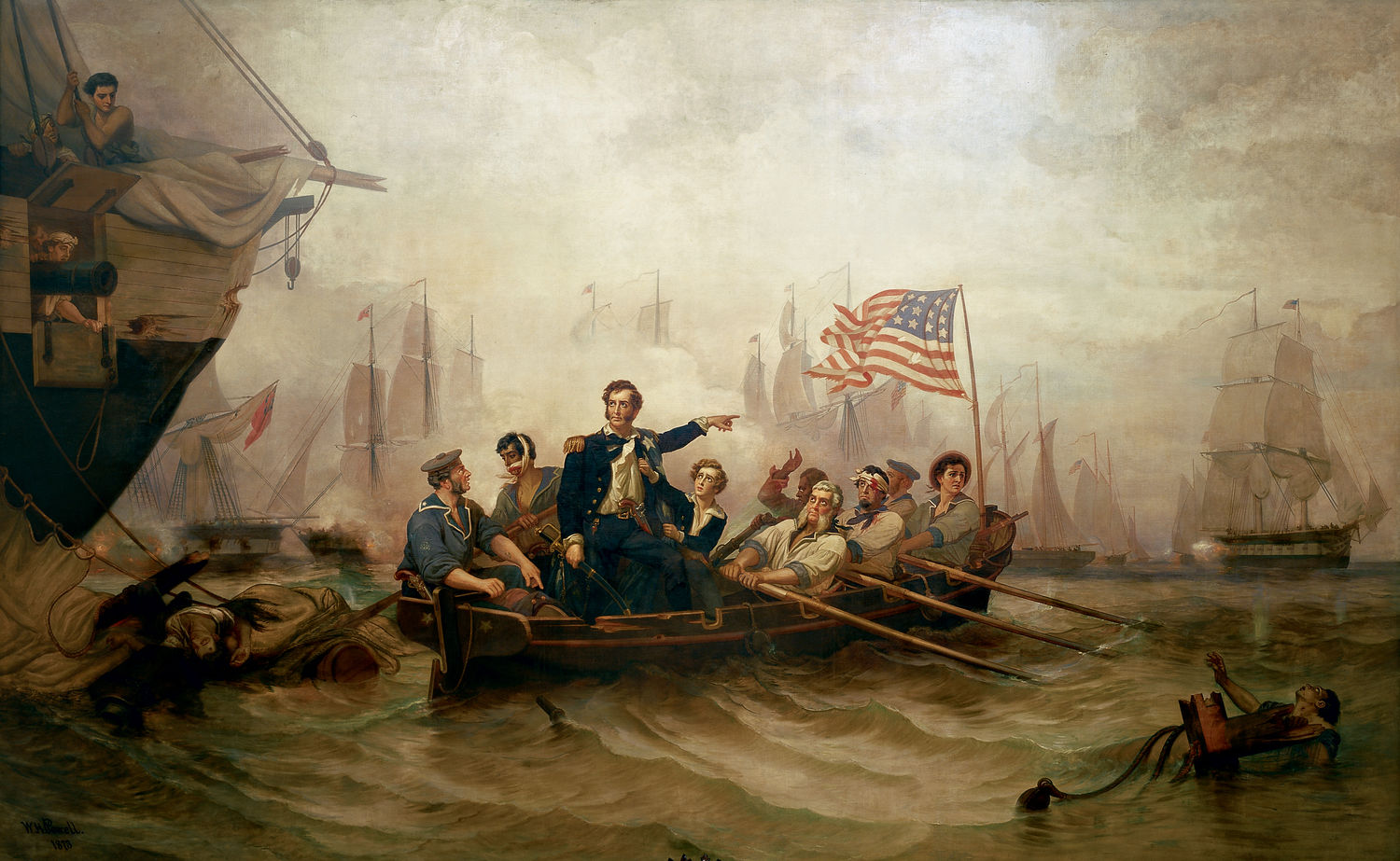
| Title | Battle of Lake Erie |
| Artist/Maker | William Henry Powell ( 1823 - 1879 ) |
| Date | 1873 |
| Medium | Oil on canvas |
| Dimensions | Sight: h. 201.125 x w. 319.5 in. (h. 510.8575 x w. 811.53 cm)
Framed: h. 242.75 x w. 358 in. (h. 616.585 x w. 909.32 cm) |
| Credit Line | U.S. Senate Collection |
| Accession Number | 33.00008.000 |
William Henry Powell, an Ohio artist who had studied with Henry Inman in New York City, received a coveted commission in 1847: the last of the historical paintings for the U.S. Capitol Rotunda. His subject, Discovery of the Mississippi by De Soto A.D. 1541, was completed in 1853. As Henry Tuckerman wrote in his 1867 Book of the Artists, it was “a commission bestowed upon him rather in deference to his Western origin than because of priority of claim in point of rank or age.” [1] That is, the new political clout of the Northwest Territory had made itself felt. This national success led his home state to commission Powell in 1857 to paint Perry’s Victory on Lake Erie for the rotunda of the Ohio Statehouse in Columbus. The work was completed in his New York City studio. The artist let it be known that he had used as models men from the Brooklyn Navy Yard and had sought authenticity in all the nautical details of the picture, an effort for which he was praised. The picture was installed in Columbus in 1865, whereupon the Joint Committee on the Library commissioned Powell, on March 2, 1865, for a painting “illustrative of some naval victory,” to be placed at the head of the east stairway in the Senate wing of the Capitol. [2] It seems certain that he was expected to repeat his Ohio Statehouse subject on a larger scale. He did so, painting it in a temporary studio inside the U.S. Capitol and completing it in 1873. For this version, it appears that Powell used as models workers then employed at the Capitol.
Powell chose as his subject the moment when Commodore Oliver Hazard Perry made his way from his severely damaged flagship, the Lawrence, in a rowboat through enemy fire to the Niagara. Powell enlarged the crew of the boat, showing six oarsmen, a helmsman, Perry, and Perry’s 13-year-old brother, Alexander, who served as Perry’s midshipman. Sources do not agree on whether Alexander in fact accompanied his brother in the rowboat, but it must have seemed an irresistible addition. In the painting, Alexander grasps his brother’s coat as if to pull him to sit, as the helmsman also urges with a gesture. Perry does not carry his battle flag; the artist chose instead to fly the Stars and Stripes from the boat’s bow. This is stirring, if inaccurate, as the “colors” were not taken from the Lawrence. One of the oarsmen is an African American. Although Tuckerman identifies him as “Perry’s black servant, Hannibal,” who responds to a near-hit in “evident consternation,” his inclusion is more likely dictated by the date of the painting—immediately post–Civil War and emancipation—than by the reality of 1813. [3]
In addition to the heroic figures in the rowboat, Powell shows three figures on the abandoned Lawrence, along with a dead sailor in the flotsam between brig and boat and a doomed figure in the water at the right side. To judge from the flags, three British ships are clustered from the left to the center in the background, and five American ships are grouped from the center to the right. Many sailors are seen in those ships. Powell’s most expressive work is found in the indistinct background, seen through gunsmoke and haze; in the water; and in the corpse atop the tangled flotsam. Powell sacrifices spatial unity, however, by ignoring the middle ground. Thus, the diagonal that is meant to lead the eye from the Lawrence through the rowboat to the distant Niagara fails to do so, despite Perry’s rhetorical pointing gesture.
Although the commodore’s heedless action of standing in the boat had exposed him as he headed for the Niagara, “Perry’s luck” became legendary. The heroic stance, as presented by Powell, may seem overdone to the modern viewer, but it was not out of step with dramatic conventions of the period. For example, Emanuel Leutze’s Washington Crossing the Delaware portrays George Washington similarly.
The Leutze canvas was exhibited in New York in 1851 and again in 1853, and it was all but universally praised for showing the hero’s determined purpose. Likewise, in describing Perry’s action in the earlier version of Powell’s Perry’s Victory on Lake Erie in the Ohio Statehouse, Tuckerman revels, “[Perry]—the central figure, the soul of the picture—is standing with outstretched arm, and resolute and confident look, unconscious of his handsome little brother, who tugs at his dress, or of the deprecating gesture of the helmsman to make him sit down and avoid the terrible exposure, of which, in the excitement of the moment, he is unaware.” [4]
1. Henry T. Tuckerman, Book of the Artists: American Artist Life Comprising Biographical and Critical Sketches of American Artists (1867; reprint, New York: James F. Carr, 1966), 458.
2. U.S. Congress, Joint Resolution 25, 38th Cong., 2d sess., 2 March 1865.
3. Tuckerman, 459.
4. Ibid.